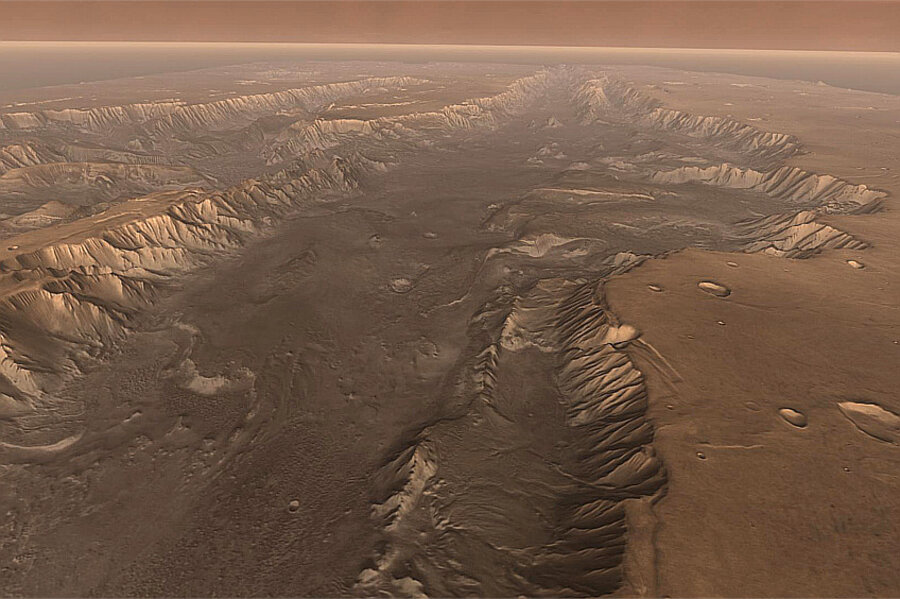Is hydrogen the secret to water on Mars?
Loading...
Mars has valleys deeper than the Grand Canyon, braided river channels, and a level seashore reaching around the northern third of the planet. These signs point to water – a lot of water – in Mars's early history. But it's too cold for liquid water now, so how could Mars have had rivers and oceans 3.8 billion years ago, back when the sun was colder and dimmer?
Just add hydrogen, suggests a team of scientists from Penn State and NASA. "A CO2 -H2 greenhouse could have done the trick," writes Ramses Ramirez, lead author of a new paper appearing in the Nov. 24 Nature Geoscience.
"You just need a little nudge," explains Jim Kasting, a Penn State professor and fellow author on the paper. "On early Mars, you can almost make it warm enough with carbon dioxide and water vapor, but not quite. You need something to push you over the edge."
Ever since the valleys were discovered in the 1970s, scientists have been trying to explain how a cold planet with a negligible atmosphere could ever have been warm enough to have running water on the surface. It hasn't been easy. Various greenhouse gases have been suggested – carbon dioxide, sulfur dioxide, water vapor – but none were abundant enough to keep Mars balmy. Also, many gases create clouds, which undercut their greenhouse effectiveness by reflecting sunlight back up into space.
Considering all the problems with keeping Mars warm, some scientists have considered a series of "transient" atmospheres. They argue that big meteor impacts could blast enough material into Mars's sky to create a temporary atmosphere that would heat the planet into a brief warm spell, lasting just long enough to flash-thaw huge chunks of ice into catastrophic floods that would pour across the surface, quickly carving the visible channels and valleys.
But the longer we look at Mars, the more valleys and channels we find, note Ramirez and Kasting. Big ones. The amount of water required to carve and shape them just isn't compatible with flash-in-the-pan transient atmospheres, they argue. So they set out to model a stable, warm climate on early Mars.
Hydrogen: an unlikely hero
They got a hint from the hydrogen-rich atmosphere of the outer planets. By itself, atmospheric hydrogen (H2 ) is nearly useless as a greenhouse gas. It's too stable and symmetrical to get excited by passing sunlight. But on Earth and on Saturn's moon Titan, hydrogen gets help from nitrogen (N2 ), and together they can trap an impressive amount of heat.
The secret is in the collisions between molecules of nitrogen and hydrogen: if hydrogen gets rattled enough, it can temporarily lose its symmetry and stability. Once unstable, hydrogen becomes a very effective greenhouse gas.
"The collisions introduce a dipole moment to the hydrogen molecule," explains Kasting, "so there's a little bit of charge offset between the negative charge in the electrons and the positive charge in the nucleus, and that's what allows it to interact with the electromagnetic radiation, to absorb infrared energy."
"This is why hydrogen has been overlooked for a long time," he adds with a chuckle. "It's not obvious that that's going to happen."
The same mechanism that works on the Earth and Titan could work on Mars, the authors say, to trap heat and create a warm, wet planet. But there's one problem: Mars doesn't have much nitrogen.
It does have volcanoes that belch methane (CH4 ) and carbon monoxide (CO), which interact in the martian atmosphere to create carbon dioxide (CO2 ) – and carbon dioxide should work just as well as nitrogen to knock hydrogen off-balance, the authors say.
When Ramirez added hydrogen into the computer models of the early martian atmosphere, it made all the difference, even using conservative estimates for the effectiveness of carbon dioxide-hydrogen collisions.
"You can get up to the freezing point, and therefore we have a mechanism to explain the valleys," says Kasting.
In fact, with enough hydrogen, you could theoretically make Mars "quite warm," he says, but it's more likely that temperatures stayed pretty chilly – just warm enough to have rainfall, rivers, and a stable water cycle.







